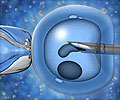An ion channel protein that plays a central role in sperm motility could be an enticing target for a new type of contraceptive that could be taken by
An ion channel protein that plays a central role in sperm motility could be an enticing target for a new type of contraceptive that could be taken by either men or women to block the process of fertilization. The newly discovered protein, called CatSper, controls the flow of calcium into the tails of spermatozoa. This influx of calicum triggers the sperm’s motor proteins, causing the tail to beat.
The CatSper ion channel is found only in a principal section of the sperm’s tail and nowhere else in the body, making it likely that a contraceptive that targets CatSper would have fat fewer side effects than a hormone-based contraceptive. Discovery of the CatSper ion channel was reported in an article published in the jouurnal Nature by Howard Hughes Medical Institute investigator David Clapham and colleagues at Harvard Medical School.“It has been known that there are ion channels in sperm,” said Clapham. “But most of the ion channels studied before were associated with the sperm head.” According to Clapham these ion channels govern processes such as the sperm’s ability to dissolve the thick outer coating of the egg. Clapham and his colleagues were performing a general screen of the human gene database for novel calcium-selective ion channel genes when they discovered one with an unusual structure that resembled other channels known to play a role in cell motility.
Using antibody tracers, the researchers revealed that the gene - which they named CarSper, for “cation channel of sperm” - was expressed only in the testes and not in any other tissue.To begin to define the role of CatSper in sperm function, the researchers knocked out the gene in mice. They found that, although the mice were normal in every other respect, and that female mice were fertile, the male mice were completely infertile.
Studies of the sperm motility of the mice were then conducted by Gloria Perez and Janathan Tilly, co-authors of the Nature article, who found that the sperm from the knockout mice were less motile and showed less directed movement than normal sperm.To find out whether the sperm from the CatSper-knockout mice could still fertilize eggs, the researchers mixed the sperm with eggs whose outer covering, called the zona pellucida, had been removed. They found that the sperm could fertilize the eggs normally, and that the eggs began to develop normally.
“So, the only thing that seems to be wrong in the sperm of these mice is their inability to penetrate the zona pellucida,” said Clapham. “While this is a bit speculative, it might be that this channel is involved in giving sperm’s tail beating a kind of turbo-charge at the last instant, when it needs more power to penetrate the zona pellucida.”Clapham said that a contraceptive based on compounds to block the CatSper channel might have considerable advantages over hormonal contraceptives.
“Hormonal contraceptives have to be taken daily throughout a woman’s fertile life,” he said. Also, they have potential side effects, such as increased risk of blood clotting and cancer.”“If a drug could be designed to block this channel specifically, it could be taken by men or women. And, it would not have to be taken for a very long period to block fertilization, perhaps only just before or after intercourse,” he said.Clapham also pointed out that some forms of male sterility, such as those caused by lack of sperm motility, might be due to defects in the CatSper ion channel.







